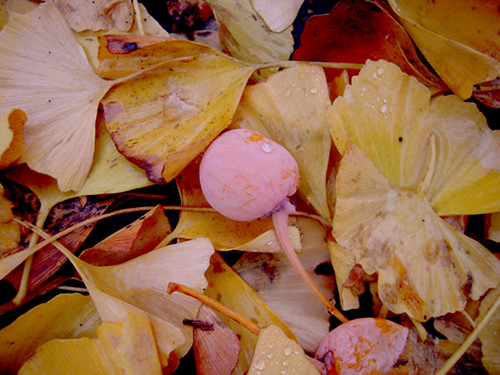
You've smelled them in or around your neighborhood. They turn bright yellow in November and December and are usually clustered in groups along streets or in parks. They are ginkgo trees.
Ginkgo trees put on quite a show, but they can be an assault on the olfactory receptors.
It wasn't until Thanksgiving weekend that I assigned ginkgo nut foraging a top spot on my "to-do" list. My aunt had brought some beautiful pearly gingko nuts or "ginnan" to the Thanksgiving table. The ginnan were pan-fried and salted. She mentioned that she had found a tree nearby that supplied endless amounts of ginkgo fruit this fall. Being the cheap bastard and umami-fiend that I am, I was really intrigued.
Ginnan is said to improve your memory and is common in the American diet in the form of diet supplements. Eating the nut itself is still quite unknown in the west, so many cities in America look like a gold mine to the Chinese and Japanese who consider ginkgo nuts a delicacy. Ginnan can be enjoyed in steamed Japanese egg custard or rice, grilled or pan-fried. The texture is firm and solid but not hard. The taste is savory without being salty with a unique nutty-popcorn like scent (when grilled or pan-fried)
While dreaming of a bowl of ginnan alongside a glass of wine, I pulled up my legwarmers and got ready to scour the street of Berkeley for my beautiful babe of a ginkgo tree.
As with many species, the men are useless. The female ginkgo trees are the ones that bear fruit. So when on the hunt, spot an area with a cluster of trees hoping that at least one or two are females.
Being a novice, I spotted a cluster that was much too young - I also didn't even know what the fruit looked like-- I only knew what the actual ginnan looked like. This row of ginkgo trees did not seem to have any fruit on them. So I proceeded to another group of trees I remember spotting on my way to yoga.
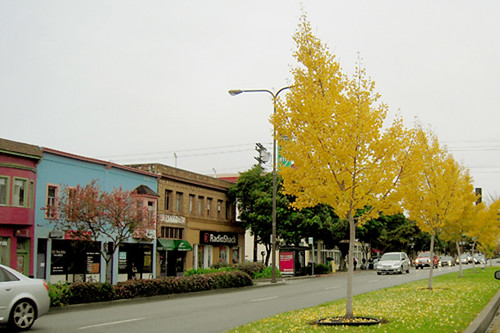
As I approached, I could smell the stench. It's a cross between poo, cheese and moldy vinegar. Yumzers.
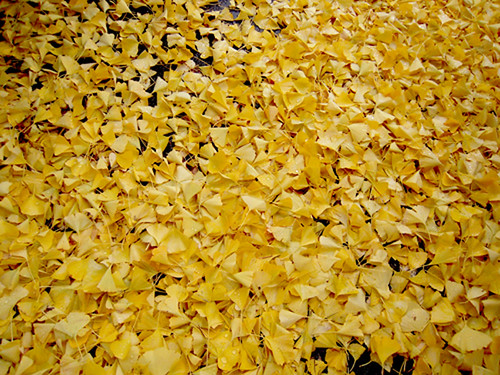
Just as I expected, the fruits were squashed and abandoned by the backs of college kids' shoes-- but there were a bunch still in tact that rolled off to the sides into the bushes. Jackpot!
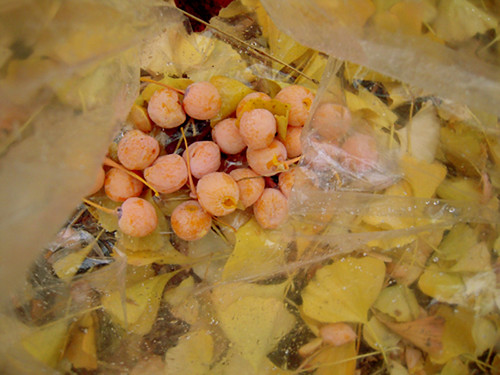
The fruit look like small apricots, in color and shape. But don't get too close because they can potentially make you nauseous if you are not used to the stench.
It was quite a thrill to find my hottie on the street corner. I came home with about 30 nuts.

According to Wikipedia
: The gametophyte (meat) of the seed can cause poisoning by MPN (4-methoxypyridoxine). MPN is heat stable and not destroyed by cooking.
Therefore, my aunt also advised that when you pick and handle uncooked ginkgo fruit, you should wear rubber gloves.
After you pick your fruit, the meat on the outside of the seed should be discarded. It easily slides off the seed. Again, make sure you are wearing gloves.
Fruit in strainer.
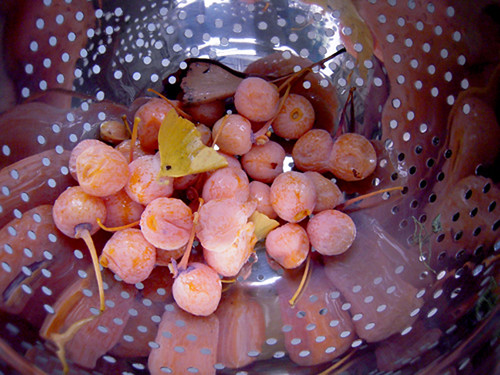
Put the seeds in a strainer and wash them under water at full blast so all the meat is cleaned off the seeds.
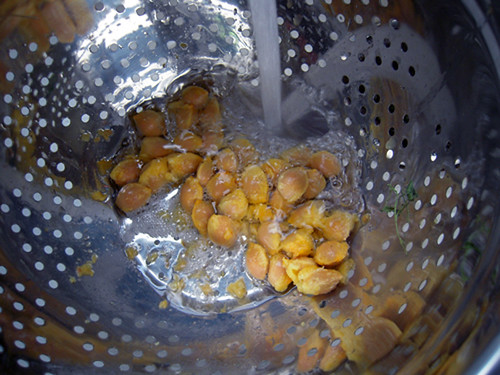
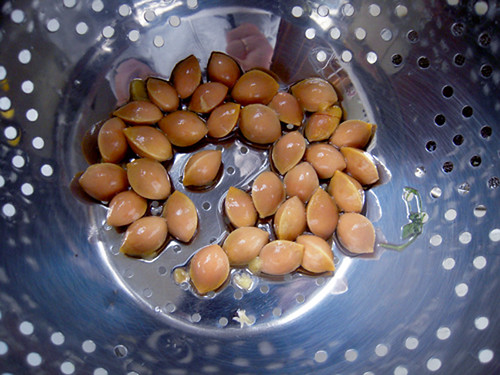
Ideally the seeds should be set to dry for a full day or longer. But my aunt said you don't have to wait a whole day if you can't wait. I fell into the later category and had them dry out for about 6 hours.
Drying on a paper towel.
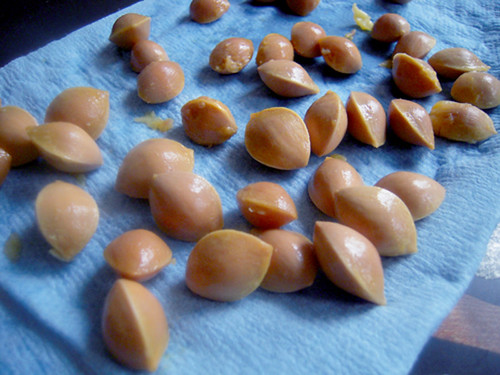 After six hours.
After six hours.
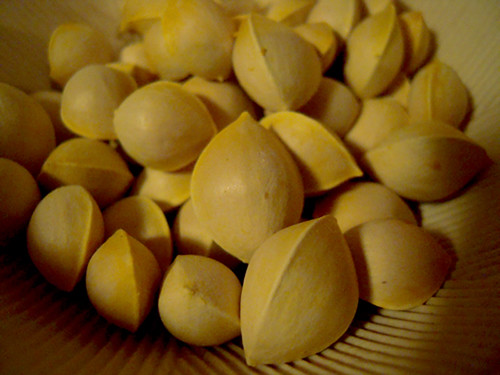
To expose the actual nut inside, you must invest in a pair of pliers and crack firmly (but not so forcefully that you smash the nut inside).
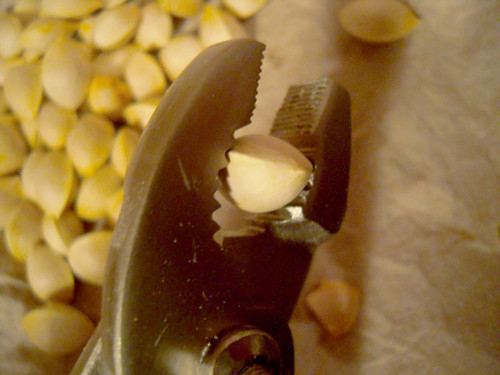
Now that the nuts are out of their shells, they are ready to be cooked.
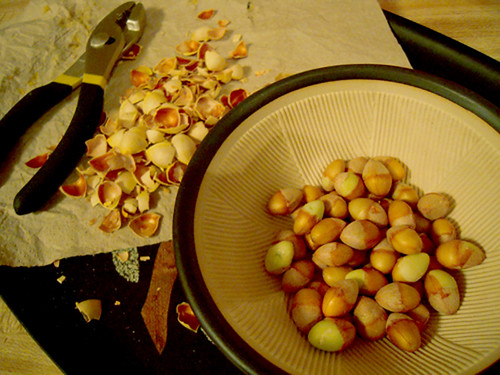
Here's the pan-fried method I've been dreaming about:
INGREDIENTS
1 tbsp of oil in a pan, heated
Handful of ginnan
Salt
METHOD
1. Heat the oil in a pan.
2. Add the ginnan and make sure they are thoroughly heated.
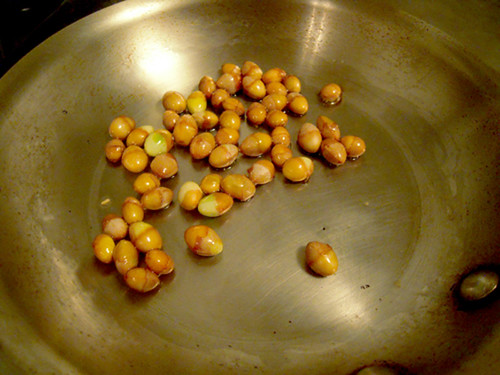
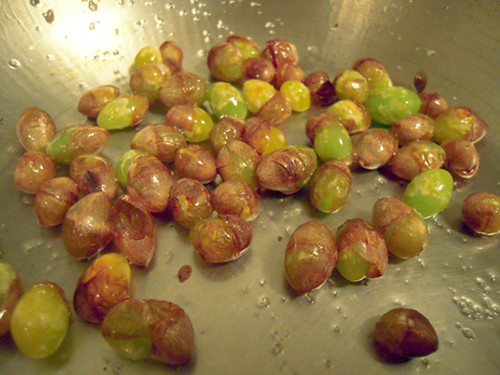
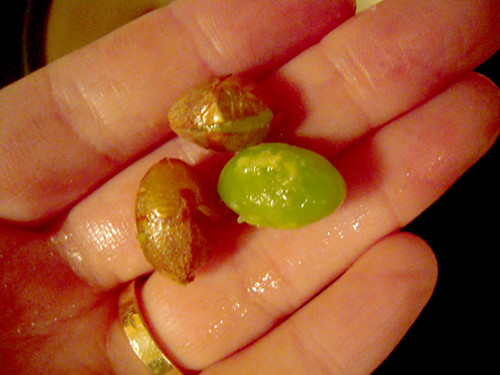
3. Sprinkle salt after they have cooled down a little.
4. Serve!
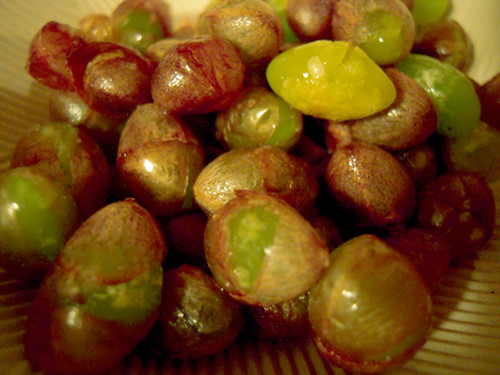
 You've smelled them in or around your neighborhood. They turn bright yellow in November and December and are usually clustered in groups along streets or in parks. They are ginkgo trees.
Ginkgo trees put on quite a show, but they can be an assault on the olfactory receptors.
It wasn't until Thanksgiving weekend that I assigned ginkgo nut foraging a top spot on my "to-do" list. My aunt had brought some beautiful pearly gingko nuts or "ginnan" to the Thanksgiving table. The ginnan were pan-fried and salted. She mentioned that she had found a tree nearby that supplied endless amounts of ginkgo fruit this fall. Being the cheap bastard and umami-fiend that I am, I was really intrigued.
Ginnan is said to improve your memory and is common in the American diet in the form of diet supplements. Eating the nut itself is still quite unknown in the west, so many cities in America look like a gold mine to the Chinese and Japanese who consider ginkgo nuts a delicacy. Ginnan can be enjoyed in steamed Japanese egg custard or rice, grilled or pan-fried. The texture is firm and solid but not hard. The taste is savory without being salty with a unique nutty-popcorn like scent (when grilled or pan-fried)
While dreaming of a bowl of ginnan alongside a glass of wine, I pulled up my legwarmers and got ready to scour the street of Berkeley for my beautiful babe of a ginkgo tree.
As with many species, the men are useless. The female ginkgo trees are the ones that bear fruit. So when on the hunt, spot an area with a cluster of trees hoping that at least one or two are females.
Being a novice, I spotted a cluster that was much too young - I also didn't even know what the fruit looked like-- I only knew what the actual ginnan looked like. This row of ginkgo trees did not seem to have any fruit on them. So I proceeded to another group of trees I remember spotting on my way to yoga.
You've smelled them in or around your neighborhood. They turn bright yellow in November and December and are usually clustered in groups along streets or in parks. They are ginkgo trees.
Ginkgo trees put on quite a show, but they can be an assault on the olfactory receptors.
It wasn't until Thanksgiving weekend that I assigned ginkgo nut foraging a top spot on my "to-do" list. My aunt had brought some beautiful pearly gingko nuts or "ginnan" to the Thanksgiving table. The ginnan were pan-fried and salted. She mentioned that she had found a tree nearby that supplied endless amounts of ginkgo fruit this fall. Being the cheap bastard and umami-fiend that I am, I was really intrigued.
Ginnan is said to improve your memory and is common in the American diet in the form of diet supplements. Eating the nut itself is still quite unknown in the west, so many cities in America look like a gold mine to the Chinese and Japanese who consider ginkgo nuts a delicacy. Ginnan can be enjoyed in steamed Japanese egg custard or rice, grilled or pan-fried. The texture is firm and solid but not hard. The taste is savory without being salty with a unique nutty-popcorn like scent (when grilled or pan-fried)
While dreaming of a bowl of ginnan alongside a glass of wine, I pulled up my legwarmers and got ready to scour the street of Berkeley for my beautiful babe of a ginkgo tree.
As with many species, the men are useless. The female ginkgo trees are the ones that bear fruit. So when on the hunt, spot an area with a cluster of trees hoping that at least one or two are females.
Being a novice, I spotted a cluster that was much too young - I also didn't even know what the fruit looked like-- I only knew what the actual ginnan looked like. This row of ginkgo trees did not seem to have any fruit on them. So I proceeded to another group of trees I remember spotting on my way to yoga.
 As I approached, I could smell the stench. It's a cross between poo, cheese and moldy vinegar. Yumzers.
As I approached, I could smell the stench. It's a cross between poo, cheese and moldy vinegar. Yumzers.
 Just as I expected, the fruits were squashed and abandoned by the backs of college kids' shoes-- but there were a bunch still in tact that rolled off to the sides into the bushes. Jackpot!
Just as I expected, the fruits were squashed and abandoned by the backs of college kids' shoes-- but there were a bunch still in tact that rolled off to the sides into the bushes. Jackpot!
 The fruit look like small apricots, in color and shape. But don't get too close because they can potentially make you nauseous if you are not used to the stench.
It was quite a thrill to find my hottie on the street corner. I came home with about 30 nuts.
The fruit look like small apricots, in color and shape. But don't get too close because they can potentially make you nauseous if you are not used to the stench.
It was quite a thrill to find my hottie on the street corner. I came home with about 30 nuts.
 According to Wikipedia: The gametophyte (meat) of the seed can cause poisoning by MPN (4-methoxypyridoxine). MPN is heat stable and not destroyed by cooking.
Therefore, my aunt also advised that when you pick and handle uncooked ginkgo fruit, you should wear rubber gloves.
After you pick your fruit, the meat on the outside of the seed should be discarded. It easily slides off the seed. Again, make sure you are wearing gloves.
Fruit in strainer.
According to Wikipedia: The gametophyte (meat) of the seed can cause poisoning by MPN (4-methoxypyridoxine). MPN is heat stable and not destroyed by cooking.
Therefore, my aunt also advised that when you pick and handle uncooked ginkgo fruit, you should wear rubber gloves.
After you pick your fruit, the meat on the outside of the seed should be discarded. It easily slides off the seed. Again, make sure you are wearing gloves.
Fruit in strainer.
 Put the seeds in a strainer and wash them under water at full blast so all the meat is cleaned off the seeds.
Put the seeds in a strainer and wash them under water at full blast so all the meat is cleaned off the seeds.

 Ideally the seeds should be set to dry for a full day or longer. But my aunt said you don't have to wait a whole day if you can't wait. I fell into the later category and had them dry out for about 6 hours.
Drying on a paper towel.
Ideally the seeds should be set to dry for a full day or longer. But my aunt said you don't have to wait a whole day if you can't wait. I fell into the later category and had them dry out for about 6 hours.
Drying on a paper towel.
 After six hours.
After six hours.
 To expose the actual nut inside, you must invest in a pair of pliers and crack firmly (but not so forcefully that you smash the nut inside).
To expose the actual nut inside, you must invest in a pair of pliers and crack firmly (but not so forcefully that you smash the nut inside).
 Now that the nuts are out of their shells, they are ready to be cooked.
Now that the nuts are out of their shells, they are ready to be cooked.
 Here's the pan-fried method I've been dreaming about:
INGREDIENTS
1 tbsp of oil in a pan, heated
Handful of ginnan
Salt
METHOD
1. Heat the oil in a pan.
2. Add the ginnan and make sure they are thoroughly heated.
Here's the pan-fried method I've been dreaming about:
INGREDIENTS
1 tbsp of oil in a pan, heated
Handful of ginnan
Salt
METHOD
1. Heat the oil in a pan.
2. Add the ginnan and make sure they are thoroughly heated.


 3. Sprinkle salt after they have cooled down a little.
4. Serve!
3. Sprinkle salt after they have cooled down a little.
4. Serve!





Comments (12)
I puked a little thinking about the process.
So, did they taste good? Those things smell like pee.
Yamahomo – I hear there are a lot of ginnan trees in Central Park. You should try it – you might not barf.
Cindy – They are really good. Especially for a late night nibble snack thing.
No Way. Also the season is way over too. It’s freaking 30 degrees high now.
Yeah, the fruits are nearing their end here too… There’s also next year.
did you feel smarter after eating them?
Hey Austyn!
I felt smarter only because I was able to enjoy a delicacy for free.
Ginnan is also served on skewers in some Yakitori places, they are delicious.
You can get them in tiny tins as well…
Yeah, my favorite place in Tokyo skewered ginnan. http://www.umamimart.com/2009/02/Tori-ina-Yakitori-in-Tokyo/
Great post. Just bought some from Japanese supremarket and was wondering how to cook them.